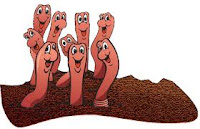Make worm compost for a healthy garden
Making compost for our gardens is as simple as finding a
shady place to make a pile of leaves, plant trimmings and grass clippings.
Left alone, a heap compost pile will produce a soil additive
that builds plant-protective beneficial micro-organisms and encourages worms to
till the soil for you.
A compost pile that is turned and watered will produce
finished compost more quickly but the quality of the finished product will be
about the same.
Our compost pile is surrounded with a stack of cinder blocks
to hold the contents in place. Other frames can be made of discarded pallets, a
wire cattle panel, or chicken wire.
The easiest method, incorporation, or composting in place,
uses no pile or bin. Holes are dug in the garden and non-protein, non-fatty
kitchen and food waste is buried. In a month or more, the waste breaks down and
contributes to the soil, fertilizing future plantings.
Any area that is not being used to grow plants can be put into service. The hole has to be large enough to bury the food waste 8-inches so animals leave it alone.
Food can be mixed with soil. Avoid digging near tree roots that will be damaged.
Most of our non-protein kitchen scraps go into a worm bin
where red wiggler worms stay busy year round making worm manure (castings) to
fertilize the garden.
Setting up a worm bin is easy using a plastic box, adding moistened newspaper strips, and some starter worms. Worms are alive so they need air, moisture, food, warmth and darkness. We put into the bin: Shredded junk mail, scraps and peelings of vegetables and fruit, banana peels, tea bags, coffee grounds, leftovers, paper towels, etc. Never add fats, meat, bones, or plastic.
Worms eat their bedding so it has to be replaced frequently. Give them plenty of moist newspaper strips and leaves. Paper bags do not break down quickly enough to be useful but cardboard and shredded paper seem to be eaten almost as quickly as their favorite foods such as baked squash. Avoid putting in large amounts of citrus peels and onions.
Worms are good at making more worms. In fair weather, with food and moisture their numbers double every 90 days.
Vermicomposting bins need red worms or red wigglers, Eisenia foetida and Lumbricus rubellus respectively.
When deciding what size your worm bin should be, consider the volume of kitchen scraps you will have available. A 5 to 10 gallon box, 24 by 19-inches and 8-inches tall would be a good start. Red wigglers live in the top 6-inches so a deep box is unnecessary. Drainage holes in the bottom are important.
An old aquarium could be put into service or a wooden box can be built from untreated wood. Whatever you choose, thoroughly clean the container and half fill it with damp strips of newspaper.
Your worm bin will need a cover that provides a dark environment but allows air in. For example, drill holes in the top of a plastic bin, use a moistened burlap bags, etc.
Their preferred temperature is between 50 and 77 F. During the summer we keep our worm bin outside under a tree and when the temperatures drop below 40 F we move it into the garage.
When feeding, check to be sure the torn newspaper is damp and the food is being eaten. Too much uneaten food creates insect problems.
 |
| Misch Lehrer at Soilutions.net composting site in Alubquerque NM USA |
My brother, Misch Lehrer, operates Soilutions (http://soilutions.net/), a composing company in Albuquerque NM. He said, “Worms have been eating organic material for millions of years so it is unnecessary to be fussy about them. Just avoid feeding them non-plant materials such as plastic, glass, metal, synthetic fabric, etc.”





Comments